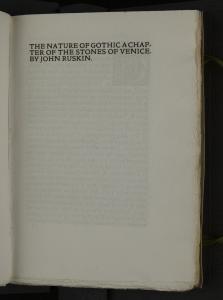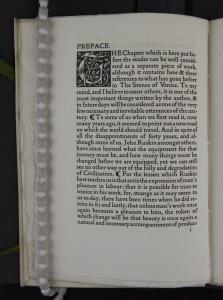

The nature of Gothic, a chapter of the Stones of Venice
1. The complaint, and the consolation; or, Night thoughts
2. The Fables of Æesop, and others / With designs on wood, by Thomas Bewick
5. News from nowhere: or, An epoch of rest, being some chapters from Utopian romance
6. The nature of Gothic, a chapter of the stones of Venice
7. Daphnis and Chloe: a most sweet abd pleasant pastoral romance for young ladies
8. The Sphinx
10. Credo
14. Bible.Old Testament. Song of Solomon.
16. Kem byt’? / V. Mai︠a︡kovskiĭ ; ris. N. Shifrin.
17. The ghost in the underblows
19. Bateau ivre
UCLA Call Number: Press Coll. Kelmscott Annex

The nature of Gothic, a chapter of the Stones of Venice

The nature of Gothic, a chapter of the Stones of Venice
The border is one of the hallmarks of the Kelmscott Press and is one of William Morris’s design creations. The border itself is a display of Morris's romantic and medievalist sensibilities.

The nature of Gothic, a chapter of the Stones of Venice
The colophon from The Nature of Gothic printed by William Morris’s Kelmscott Press in 1892.
Creator: Ruskin, John
Publisher: George Allen
Publication Place: London
Date of Publication: 1892
Dimensions: 21 cm x 15 cm x 2 cm
Physical Description:
-->
The book is firm and substantial to the touch but the volume itself is lightweight. The vellum binding is smooth to the touch while it is just barely curving and uneven with the stiffness of the vellum. The fore edges of the vellum binding are scored and folded an eighth of an inch along the fore–edge of the book to just barely cover a part of the page length of the book. The spine of the book has &dquo;The Nature of Gothic by John Ruskin” stamped in bright gold in the capital letters of the “Golden” type. The binding has four green silk ties that are each an inch from the top and bottom on both the front and back book covers leaved into the binding itself. These ties might be used to tie the volume closed in the tradition of a book clasp. Once open, the book creaks with the movement and reveals clean and bright white fine handmade paper pages. The pages have deckled edges. There is a book label on the lower outside corner of the front cover that specifies that this volume belonged to William Andrews Clark, Jr. The image of this burned a brown stain into the lower outside corner of the first end paper. There are three blank endpapers that lead to the title page of the book which is very plain. Following the title page is Morris’s preface to the book, which then leads into Ruskin’s text. The text itself is bold and dark. This is accentuated by the large white margins that surround the text and give it prominence. There are margin notes at the top of each page. There are sixteen woodblock images included within the text of Gothic elements that illustrate Ruskin’s content. Throughout the book, large wood cut initials are used to begin chapters and paragraphs. The colophon at the end includes the printer's mark composed of a designed border containing the name &ldqiuo;William Morris” on the bottom with a tree inside containing the “Kelmscott” press name.
Provenance:
According to the inventory of the Clark Library done in 1936 by the cataloger at the time, Frank Lundy,The Nature of Gothic was purchased in London for $18.00. This purchase may have been made by Mr. Clark but there was no receipt to directly confirm this purchase.
Lundy, Frank A. William Andrews Clark Memorial Library: Inventory. December 21, 1936. Private holding of the Clark Library.
Condition:
The book is in very good condition. The vellum binding is still very stiff and has retained its off–white complexion without very much evidence of handling. All four green silk ties are still attached to the cover and are in good condition. Once the book is open, there is a dark brown stain from William Andrews Clark’s personalized book label on the lower outside corner of the flyleaf. The pages are all in excellent condition with no tears, stains or foxing.
Additional Info:
Printed on an Albion press. 500 copies were printed. This volume was issued on March 22, 1892.
Interpretation:
An early printing from William Morris’s Kelmscott Press, The Nature of Gothic: A Chapter of the Stones of Venice, by John Ruskin can be viewed as a statement of Morris’s ideals as a Marxist and a socialist. Ruskin’s thoughts about the spiritual nature of craftsmanship and the importance of craftsman welfare were influential on the Arts and Crafts socialist movement that developed in late 19th Century England. The Arts and Crafts movement grew out of discontent with the changes sweeping the world with the onset of industrialization, and encouraged a return to handcraftsmanship and design based on beauty. Ruskin believed that Gothic architecture found its nobility in imperfection and that the Christian faith allowed craftsmen of the time to work freed from an expectation of perfection. Ruskin mourned the fate of his contemporary craftsmen to the larger machine of industry and the poor quality craftsmanship of mechanization. William Morris was encouraged by Ruskin’s poetic musings on the beauty of Gothic architecture, which stimulated his inclination towards medievalism. Ruskin’s concept of finding joy in labor would prove to be one of the most prevalent themes in Morris’s writings and would manifest itself in his design practice, the Kelmscott Press and the titles Morris printed.
However, it should not be forgotten that Morris aimed for the volumes produced by the Kelmscott Press to be wholly artistic creations of merit and an occasion of beauty and romantic ideals. The books themselves were a manifestation of his worldview. This is as apparent as ever with his printing of Ruskin’s The Nature of Gothic in Morris’s perceived artisanal manner of a craftsman with all the detail and workmanship that goes into the art of printing itself. Interestingly, Morris employed multiple craftsmen to create his vision of the book as an embodiment of medieval ideals. However, each craftsman specialized in the task he was assigned, and Morris was deeply involved in the design and detail of each book.
The combination of Ruskin’s condemnation of industrialization and the division of labor within The Nature of Gothic and Morris’s manifestation of these ideals of craftsmanship, beauty of design and joy in labor via the Kelmscott Press is one of the cornerstones of the Arts and Crafts movement itself.
Text Content Description:
The Nature of Gothic is an essay by John Ruskin that is embedded in his larger work, The Stones of Venice. Through the course of the essay, Ruskin underscores the idea that Gothic architecture is distinguished by the freedom of the craftsmen who created it. He feels that classical architecture is artificial, and that its pristine perfection exemplifies the suppression of individuality that the desire for perfection and uniformity entails. He extolls the “beautiful imperfection of the Gothic.” Ruskin argues that Gothic is the expression of the artisan’s joy in free and creative work. The worker must be allowed to express his own personality and ideas, ideally through the use of his own hands and not machinery. He argues that men are broken into little fragments by the division of labor which leads to a man having only the ability to make a small part of a greater whole, rather than to a craftsman who is able to create the whole from the smaller pieces he creates. This breakdown is not only the breakdown of society, but of the soul of man himself. With this breakdown everything is manufactured, short of man himself, but that if a man sacrifices his abilities to create entire constructs, that man will lose portions of his soul through this degradation. Ruskin then lays out three rules to regulate the demands on the workman and to produce the “results of healthy and ennobling labor.”The Nature of Gothic is a study and discussion of Gothic architecture while also acting as an condemnation of the rising industry of the 19th century and the ensuing class system with its long–term effects.
Contributor: Stella Castillo